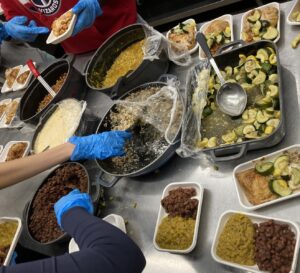New Approaches to Old Problems: Innovative Initiatives to Fight Campus Food Insecurity
- by Elise Kulers
 Across the US, food insecurity has steadily increased over the past few years. Approximately one in six individuals across the country experience unreliable access to food. On college campuses, this trend is no different.
Across the US, food insecurity has steadily increased over the past few years. Approximately one in six individuals across the country experience unreliable access to food. On college campuses, this trend is no different.
The National Center for Education Statistics recently released data from 2020 showing that 23% of undergraduate students experience food insecurity, more than double the national rate among all U.S. households. These basic need insecurities are exacerbated by racial disparities. According to the Hope Center at Temple University, Indigenous and Black students experience the highest rates of food insecurity, at around 50% throughout the pandemic.
The Hope Center, an action research center focused on equity in higher education, defines food insecurity as “the limited or uncertain availability of nutritionally adequate and safe foods in a socially acceptable manner.” Unreliable access to food carries deep implications for psychological, social, and physical well-being, often causing stress and negatively impacting students’ academic performance. While awareness of this widespread problem is growing, it can easily fly under the radar, making it difficult to connect students with available resources due to the stigma that might prevent those experiencing food insecurity from seeking support.
A Range of Solutions
When we published “When Students Are Hungry: An Examination of Food Insecurity in Higher Education” in 2018, the goal was to understand the scope of the largely understudied issue and provide potential next steps. The study highlighted innovative partnerships and solutions employed by college campuses across the country while identifying campus and federal policy changes to increase access to basic needs for all students.
The report explains that students skip meals for a number of reasons. They may face difficult financial tradeoffs between food and other basic needs, or struggle to make time to eat between juggling classes and other responsibilities. Financial aid might fall short while tuition costs continue to rise, and students who stay on campus during breaks may be left without adequate food options if dining halls are closed. Plus, most college students are ineligible for federal benefits like the Supplemental Nutrition Assistance Program (SNAP) unless they work at least 20 hours per week or have children.
There are some classic examples of how college campuses have provided resources for food insecure students in recent years, like food pantries, meal plan scholarships, expanded dining hours during breaks, and swipe donation programs. Yet some newer, varied approaches to making sure students’ needs are met have emerged, supported by our Bon Appétit teams.
Inventive Ways of Meeting Students’ Needs

Filling to-go containers at Emory University
For instance, at Emory University in Atlanta, GA, student leaders of Slow Food Emory have spearheaded a new food recovery program to redistribute food to students in a destigmatized way. After dinner on Tuesdays, Wednesdays, and Thursdays, volunteers pack up leftover food from the dining hall into individual containers to pass out in the library where many students are studying, adding a new level of convenience for a reliable, just-cooked meal. This is a win-win for addressing food insecurity on campus while also making sure perfectly good food doesn’t go to waste, a key component of our companywide waste diversion goals.
While food pantries vary in their offerings and approach, they are generally not known to offer unlimited access or an abundance of fresh produce. The Monarchs Food Pantry at St. Edward’s University in Austin, TX presents a refreshing alternative. The pantry, supported by the City of Austin and the Central Texas Food Bank, is in the center of campus, open 24/7 and free for all students. In addition to shelf-stable goods, they have access to protein, dairy, and fresh produce, supported with regular donations by the Bon Appétit team at St. Edward’s.
The Butler Food Pantry at Butler University in Indianapolis, IN recognizes that access to nourishing meals goes beyond access to groceries – it includes knowing how to feed yourself. Supported by the Bon Appétit team at Butler, the Office of Service and Community Engagement has hosted a series of cooking classes highlighting pantry-friendly recipes. For instance, one demo featured sesame noodles, a quick, inexpensive, plant-based recipe made with pantry staples that is easily adapted to the limitations of student residences. The food pantry also manages a swipe donation program that redistributes dining swipes to students who need a meal. Last semester, over 200 swipes were donated.
At Macalester College in St. Paul, MN, MacShare is a student-run food co-op that seeks to address food insecurity by bringing fresh, local food to students on campus at an affordable price. They work with The Good Acre, a Farm to Fork partner at Macalester and nonprofit food hub, and other partners in the Twin Cities to purchase fresh produce and bulk goods at wholesale prices, which they sell to students at cost. The Macalester Bon Appétit team purchases all leftover food that isn’t distributed to students, creating a closed-loop, waste-free program.
Food Insecurity Has Structural Roots
While these food security initiatives are inventive and effective at providing college students with regular access to food, experts also suggest deeper structural changes. The Hope Center’s 2023 Federal Policy priorities include policies that strengthen the social safety net, provide housing support, and relieve student debt, recognizing that food insecurity often goes in tandem with other financial and basic need insecurities.
Across the US, Swipe Out Hunger has played a key role in addressing food insecurity among college students. With over 750 partner campuses (including many served by Bon Appétit), they help connect college students with funding and program support for on-campus food security solutions. Over the past 14 years, the organization has supported over 6.8 million meals through meal swipe donations and campus food pantries.
At the same time, the organization is invested in upstream state and federal policy initiatives to end college student hunger. The Hunger Free Campus Bill, written by Swipe Out Hunger, has been successfully passed in nine states so far. The legislation has dispersed over $112 million to fund food security initiatives at public colleges across the country so far, an encouraging victory with room for expansion across the rest of the nation.
In partnership with committed student groups and campus offices around the country, our teams are proud to support efforts to address this widespread yet often hidden struggle that many students face and will continue to look for creative solutions on our campuses and beyond.